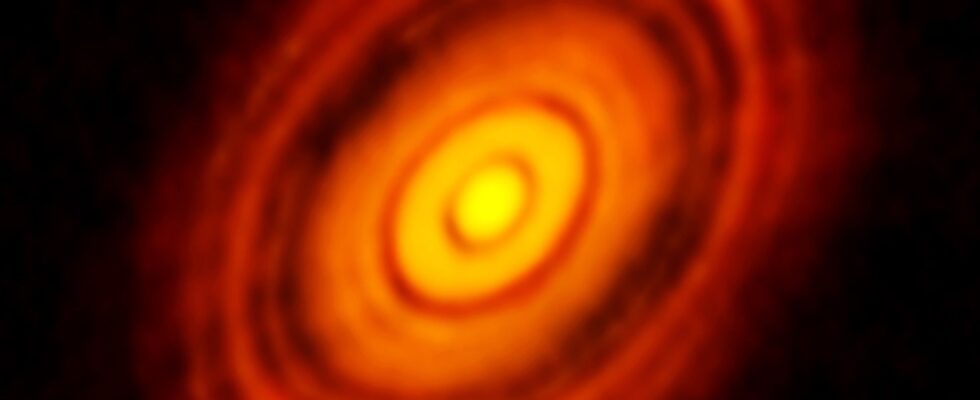What was the solar system like before the formation of the Earth? The James Webb Space Telescope provides the beginning of an answer to this question with the discovery of a protoplanetary disk, which contains a large quantity of carbonaceous molecules, essential to life.
If James Webb (JWST) has accustomed us to wonderful images of huge clusters of galaxies measuring several light years, the space telescope will also search for the infinitely small through the Universe.
A study published in Nature Astronomy May 11, 2023 looks back on a fascinating discovery: the composition of a protoplanetary disk. Concretely, it is a disparate set of several chemical elements in orbit around a star. All this matter will gradually come together to form planets. Which means the ingredients for future worlds are already in this disk, and here researchers have identified amazing hydrocarbon molecules. ” There are several types of gases containing the chemical element carbondetails for Numerama the main author, Benoît Tabone, CNRS researcher at the University of Paris-Saclay. Carbon has mixed with other elements to produce molecules that are sometimes astonishing. »
These molecules are acetylene, diacetylene and benzene. These last two elements have never been found before in a protoplanetary disk. ” There were studies before admitting that these detections were possiblesummarizes Benoît Tabone, but this is the first time that we have observed them for real. »
A zoom on carbon molecules
A feat made possible by the JWST, and more particularly its MIRI instrument. This infrared spectrometer has the ability to analyze the chemical elements present on a celestial body with unprecedented precision. The previous comparable instrument was the Spitzer Observatory, put into orbit in 2003 and which took a well-deserved retirement in 2020. But its potential was much less than that of the James Webb Space Telescope, whose infrared vision reveals a much higher amount of detail.
MIRI therefore targeted the disc named J160532, somewhere nearly 500 light-years from Earth. An interesting choice, because the star in question is rather young, so the planets around it have not yet formed. In addition, it is small, and studies have shown that less massive stars have more rocky planets around them.
Either way, the JWST observations may have provided an astronomical amount of data, but researchers have yet to figure out what they have in front of them. For Benoît Tabone, there is above all an enigma to be solved: “ The interstellar medium contains carbon, but also oxygen, so why in this protoplanetary disc, we have essentially carbon, but very little oxygen? »
The theory is as follows: the carbon was in the form of grains which were literally vaporized by the activity of the star, which was rather intense at this period of its “life”. As a result, this carbon gas found itself mixed with all the surrounding elements, providing a chemistry largely based on carbon.
A scenario very similar to that which led to the formation of the Earth, the authors of the study suggest. ” This process tends to favor the appearance of silicate materialsspecifies Benoît Tabone. Clearly, these are rocks, and therefore ultimately telluric planets like Earth. In the meantime, in our solar system, the carbon that was not accreted by the planets remained as a gas and took a long fall towards the Sun. The one present in the outer solar system has been swallowed up by gas giant planets like Jupiter. But, since J160532 is a smaller star, it will mostly be a source of rocky planets.
A window on the Earth before its formation
If this carbon-rich disk represents an image of our solar system before the formation of the planets, can that mean that it too will contain a planet as hospitable as Earth? The question is very far from having an answer. However, carbon being essential to the formation of life, the track deserves to be dug. ” Paradoxically, the Earth contains little carbonadds Benoît Tabone, just enough to form the complex molecules that led to life. But, not too much, otherwise the atmosphere would be saturated, and the conditions would undoubtedly be very different.. »

The protoplanetary disc at the origin of the Earth certainly showed similarities with that observed around J160532. However, there remains another unanswered question according to Benoît Tabone: “ Is this disc an exception, or do all discs around small stars have this carbon glut? We are only at the beginning of the observations and we hope to know more soon. »
In his program, the researcher plans about fifty other observations of protoplanetary disks, of different masses and ages, in order to make a statistical study of these objects. ” Our dream would be to discover that this process of destruction of carbon grains occurs systematicallyassures Benoît Tabone. This would show us which terrestrial planets are geologically similar to Earth. Measurements that are not enough to determine which are also habitable, but the step is essential for understanding the exoplanets discovered daily.
Moreover, these same exoplanets are also placed under the magnifying glass of the JWST. His instruments allow him to analyze the composition of the atmosphere of these distant worlds, with the hope of finding breathable air elsewhere. Such studies will not, for sure, find extraterrestrial life forms, but will serve to reconstruct the path of a planet before its birth, and until its formation.
If you liked this article, you will like the following ones: do not miss them by subscribing to Numerama on Google News.
